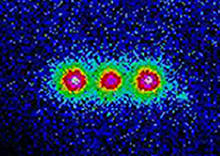Quantum Information Science - Infrastructure for 21st-Century Innovation
Problem/Challenge

America's future prosperity and economic security may rely in part on the exotic properties of some of the smallest particles in nature. Research in quantum information seeks to control and use these properties for scientific and societal benefits.
Quantum information science relies on using individual atoms, molecules, and other tiny particles to store, process, and transport data. Researchers already are using quantum information science to generate "unbreakable" codes for ultra-secure encryption. They may someday build quantum computers that can solve problems in seconds that today's best supercomputers could not solve in years. Advances in quantum information science have the potential to expand and strengthen the U.S. economy and security in the 21st century just as transistors and lasers did in the 20th century.
For example, quantum information approaches may provide a solution to the "brick wall" that will limit silicon-based microelectronics as the technology approaches atomic scales in the coming decades. Continuing to achieve additional computing power and speed will then be possible only through a revolutionary new approach such as quantum information science.
Proposed NIST Program
NIST proposes to accelerate advances in this critical field through three complementary efforts: (1) an expanded in-house program to build on recent advances in quantum information science; (2) an enhanced effort to exploit the fundamental properties of quantum systems to develop new metrology tools and methods, and (3) funding for a Joint Quantum Institute that would blend the expertise, talents, and strengths of NIST, a university, and the National Security Agency.
NIST is a world leader in quantum research with several world-renowned scientists, including three Nobel laureates. NIST work, for example, in using ions to build the equivalents of transistors and logic components for a future quantum computer is widely recognized as one of the most advanced quantum information research programs in the world.
The goal of this initiative is to ensure U.S. leadership in this evolving new technology. Projects will include groundbreaking research needed for development of quantum repeaters and quantum-logic based atomic clocks; organizing quantum communications systems that are compatible with the existing Internet; insights into quantum behavior that translate into improved standards based on the constants of nature; and recruitment and training of the "best and brightest" young scientists and engineers to the field.
Expected Impacts
Benefits to the U.S. economic security will include improved security for electronic commerce, maintenance of the U.S. lead in computing and information processing, improved accuracy for electrical and other standards based on better understanding of quantum systems, and establishment of U.S. industry as the leader in the emerging field of quantum engineering.

